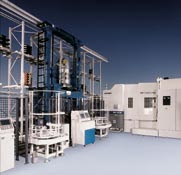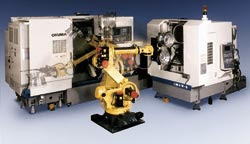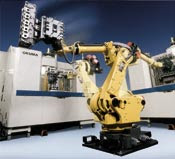While the ongoing development of machine tool and automation technology has done a remarkable job of keeping pace with industry’s increased demand for more reliable and productive systems, affordability remains as important an issue as ever. Naturally, today’s shop owners typically seek an accurate measure of the return they can expect on their investment in automation. Fortunately, they have at their disposal several sources of financial and technical guidance.
Evaluating the return on investment a shop owner can expect from a move to automation comes down to knowing the market for the parts that will be produced by the cell operation being considered. In fact, it is often the prospect of winning a large contract to machine significant quantities of identical or similar parts that encourages the managers of shops to consider automation in the first place. Of course, the cost of producing those parts is a critical factor in the calculations required to accurately project profitability.
Typically, shop owners can expect the transition to robotics and automation to entail a reasonable payback when a group of two or three machines are involved in the production of similar parts on a regular basis. Ideally, these machines should each have dedicated operators and be running at least two, if not three, shifts daily during the workweek. Even with the variable cost of labor from shop to shop, such a scenario is typically a candidate for a successful automation effort.
Another method of anticipating and evaluating the cost of moving to robotics is to apply a spindle-based calculation. Most owners usually find that when the cost of automating a spindle can be brought within the range of $50,000 per spindle, the time is usually right to make the move to automation. In other words, estimating the cost of a spindle at about $100,000, the projected cost of most successful automation efforts generally falls in the range of 50 percent of the cost of the CNC machine tool.
Of course, part weight, operator fatigue and other factors that put operators at risk of on-the-job injuries can skew calculations to the point that can justify even greater investments in robotics and automation. Fortunately, machine shop managers are not faced with making these decisions alone.
It is currently a trend for machine tool distributors to have both metalworking and automation expertise under one roof. A distributor like Ellison offers exactly this mix of services to its customers. “Typically, shop owners rely on their relationship with a distributor to gain the required access to any one of a number of automation suppliers or a third-party integrator who will then join the team to begin exploring solutions for a shop’s program.
“Some years ago, Okuma decided to climb the learning curve with the dedication of its Okuma Technology Institute,” Mr. Burg says. The Charlotte, North Carolina-based facility is home to Center for Advanced Manufacturing Technology. From the start, OTI worked with builders of systems ranging from conveyors and loaders to quality control and trend monitoring. “Today, those programs are the basis of the services that alter distributors without in house staff and resources can offer their customers.”
The interchange between members of the builder’s distributor network resembles a simplified version of the technology transfer efforts commonly seen on a global basis in contemporary high-technology industries. In practice, Mr. Burg and his team may work with an associate Okuma distributor in a remote location at the request of factory officials.
Working through OTI, Ellison Automation helps the associate Okuma distributor put in place the robotics and automation technology his customer requires. Conversely, if that customer has expertise in shaft turning for hydraulic components that Ellison lacks, that working knowledge can benefit customers in Illinois as the transfer of acquired process knowledge finds its way back through the OTI network to an Ellison customer.

 Supplementing Gauer's experience the machine shop is equipped with the latest Mori Seiki CNC machines and the latest in CAM software technology. Our CNC Lathes, Horizontal and Vertical Milling Machines enable Gauer to produce high quality parts at the most competitive prices. Having other capabilities such as welding, burning, punching, and bending, all in house enables Gauer to provide complete fabricating services to fill any requirement. Contact a Gauer sales representative anytime, and receive knowledgeable and courteous support with all of your machining needs.
Supplementing Gauer's experience the machine shop is equipped with the latest Mori Seiki CNC machines and the latest in CAM software technology. Our CNC Lathes, Horizontal and Vertical Milling Machines enable Gauer to produce high quality parts at the most competitive prices. Having other capabilities such as welding, burning, punching, and bending, all in house enables Gauer to provide complete fabricating services to fill any requirement. Contact a Gauer sales representative anytime, and receive knowledgeable and courteous support with all of your machining needs.






.jpg)






